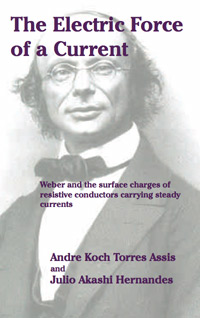The Electric Force of a Current - 'Back to Basics' on Electromagnetism
As happens so often in science, important works of pioneers are overlooked, suppressed, poorly understood and therefore remain unknown to students and professionals. Prof. Andre Koch Torres de Assis of the University of Campinas in Brazil tells of such a case in his recent book, co-authored with Julio Akashi Hernandes. The works of two German scientists - Wilhelm Weber and Gustav Kirchhoff - on fields that form around current carrying wires, are detailed in a new book titled The Electric Force of a Current: Weber and the Surface Charges of Resistive Conductors Carrying Steady Currents.

The book is published by Apeiron, Montreal, it has 239 pages, the ISBN number is 978-0-9732911-5-5. The paperback edition is also available from Amazon.
A PDF of the book (5 MB) can be downloaded from Assis' webpage, and the cover is available there as well.
According to a message from Prof Andre Assis, the book is devoted to answer two main questions:
(A) Is there a force between a resistive wire carrying a steady current and an external point charge when they are at rest relative to one another? In particular, is there a component of this force which depends upon the voltage of the battery connected to the circuit? This first question can also be phrased as: A stationary and resistive wire carrying a steady current generates an external electric field?(B) Is this wire neutral at its internal points and along its surface?
"In the first three Chapters we present the opinions of many eminent scientists as regards these questions. Then we present theoretical reasons and experimental results showing why the answer to the first question is affirmative and the answer to the second question is negative, contrary to many statements against these points of view. These first few Chapters should be of interest to most readers.
We then present many analytical calculations of this force and distribution of surface charges in important configurations of steady currents: (straight wire, coaxial cable, transmission line, solenoid, toroidal conductor). We compare the calculations with many experimental results.
We include two Appendices discussing the pioneering works of Wilhelm Weber and Gustav Kirchhoff. They showed the necessity of these surface charges in resistive wires carrying steady currents. Weber was the first to try to calculate their distribution for a straight wire and for a ring. At the end of the book we quote 259 references related to this topic.
I take this opportunity to inform that Weber's main work in which he derived his force law from Ampere's force between current elements is now available in English translation. This is only the first of a specific series of 8 large papers published by Weber, with the series dedicated to electromagnetic measurements. Weber's force depends not only upon the distance between the interacting charges, but also upon their relative velocity and their relative acceleration. Complete English translation in PDF format (2.2 MB):
http://www.ifi.unicamp.br/~assis/Weber_1846.pdf
Weber's work discussed in the Appendix quoted above is the second paper of this series."
Clearly, this is not a book for all readers, but some of you may be interested in the specific problems it discusses.
Here is the book's foreword:
- - -
Foreword
Is there an interaction - some reciprocal force - between a current-carrying conductor and a stationary charge nearby? Beneath this simple question lie some remarkable misunderstandings, which are well illustrated by the fact that the answers to it commonly found in the scientific literature and also in many text books are incorrect.
In case there is any uncertainty about the answer, all doubt will be eliminated by this book. It tackles the question in a brilliant and comprehensive manner, with numerous hints for relevant experiments and with impressive mathematical thoroughness.
It is astonishing to learn that, as early as the middle of the 19th century, the German physicists Weber and Kirchhoff had derived and published the answer to this problem; however, their work was poorly received by the scientific community, and many rejected it as incorrect. The reasons behind this scientific setback, which are presented in detail in this book and supported with numerous quotations from the literature, represent a real treasure trove for readers interested in the history of science.
It becomes clear that even in the exact science of physics people at times violate basic scientific principles, for instance by referring to the results of experiments which have never been carried out for the purpose under discussion. This book helps readers not only to develop a detailed knowledge of a seriously neglected aspect of the so-called simple electric circuit, but reminds us also that even eminent physicists can be mistaken, that mistakes may be transferred from one textbook generation to the next and that therefore persistent, watchful and critical reflection is required.
A didactic comment is appropriate here. The traditional approach to teaching electric circuits based on current and potential difference is called into question by this book.
When dealing with electric current one usually pictures drifting electrons, while for the terms "voltage" or "potential difference" one directly refers to the abstract notion of energy, with no opportunity for visualization. Experience shows that only few school students really understand what "voltage" and "potential difference" mean. The inevitable result of failure to understand such basic terms is that many students lose interest in physics. Those whose confidence in their understanding of science is still fragile, may attribute failure to grasp these basic concepts as due to their own lack of talent.
Physics remains a popular and crucial subject, so the large numbers of students who each year study the subject implies that the search for less abstract and therefore more readily understood alternatives to traditional approaches is urgent.
This book offers such an alternative. It shows that in respect to surface charges there is no fundamental difference between an electrostatic system and the flow of an electric current. It refers to recent curriculum developments concerning "voltage" and "potential difference" and presents a comprehensive survey of related scientific publications, that have appeared since the early papers by Weber and Kirchhoff.
Why should we refer to drifting electrons when we teach electric current and yet not refer to drifting surface charges when teaching voltage or potential difference?
The final objective of the curriculum when voltage is covered will certainly be to define it quantitatively in terms of energy. For didactic reasons, however, it does not seem to be justifiable to omit a qualitative and more concrete preliminary stage, unless there is a lack of knowledge about the existence of surface charges. In the present market there are newly developed curriculum materials that cover basic electricity, to which the content of this book relates strongly. Comparison of the approach that this book proposes with more traditional approaches should dispel any doubts about the need for the methods that it describes.
This book provides a crucial step along the path to a better understanding of electrical phenomena, especially the movement of electrons in electic circuits.
Hermann Haertel
Guest scientist at the Institute for Theoretical Physics und Astrophysics
University of Kiel, Germany





From a recent email of William Alek:
I found a couple of intriguing articles concerning NEGATIVE resistance:
'Negative Resistance' Surprises Material Scientists
"... Two US scientists claim to have discovered a new electrical effect called negative resistance in carbon-composite materials. And when materials exhibiting negative resistance are combined with 'normal' materials, they appear to have zero resistance to electrical current, similar to superconducting materials. Moreover, this behaviour persists to room temperature ..."
YES!
Negative Reststance Found in 2D Electron Gas
"... Negative resistance, therefore, ought to imply that energy is somehow being supplied to the electrons, making them move faster. ..."
"... In theory, some of the energy lost to resistance by electrons travelling from the first terminal to the second could find its way to electrons passing from the second to the third terminals. These energized electrons would then move with a forward current in a reversed electric field – in other words, having a negative resistance – while obeying the first law of thermodynamics. ..."
Is Carbon Graphene behaving similar to the medium between terminals two and three as described above? YES! Carbon Graphene acts as a "mini" particle accelerator on flowing electrons. The nature of these electrons is changed into what are called Dirac Quasiparticles. For those curious about Dirac Quasiparticles and their fascinating properties, please visit my Breakthrough News Article Section
Carbon Graphite used in such products as gouging rods are avaliable at any local welding supply store, and are composed of layers of Carbon Graphene. I would consider these rods ideal for spark gap experiments and I used them in my experiments.
Bill
---
William S. Alek, INTALEK, INC.
Low Energy Nuclear Fusion, Antigravitational and Temporal Transportation Technologies
eGroup: http://groups.yahoo.com/group/TheRanchConsortium
URL: http://www.intalek.com/
Jan Olof Jonson from Sweden comments (by email):
The so-called Lienard-Wiechert potentials constitute a fundamental part of basic electromagnetic theory. Through these potentials both the electric and the magnetic fields are accordingly derived, and in following steps Maxwell’s equations may also be derived. Short-to-say, if succeeding in showing any fundamental fallacy in the derivation of the Liénard-Wiechert potentials, one could claim to have falsified whole Maxwell’s theory, a very important prerequisite if intending to pave the way for a radically new theory. Yet, the author does not intend to create a new theory of his own. Instead, at hand is an attempt to give credit to the far older theory than Maxwell’s, namely basically Coulomb’ s Law of 1785 (or Cavendish 1771).
By philosophical reasons, Coulomb’ s theory must again be restored, if finding a new way to apply it, simultaneously falsifying Maxwell’s theory, due to the precedence of the first one.
See: Refutation of Feynman’s derivation of the Lienard-Wiechert potentials
Other papers by Jan Olof Jonson:
The Magnetic Force between Two Currents Explained Using Only Coulomb's Law
The Law of Electromagnetic Induction Proved to be False Using Classical Electrostatics
Extension of Weber's approach using CRT data results in a model, which not only captures standard relativistic effects
in optics, high-energy particles, and gravitation, but also explains apparent discrepancies
between predicted and measured energy (i) in high-energy-particle absorption experiments
and (ii) in the classical beta-ray spectrum of radium-E.